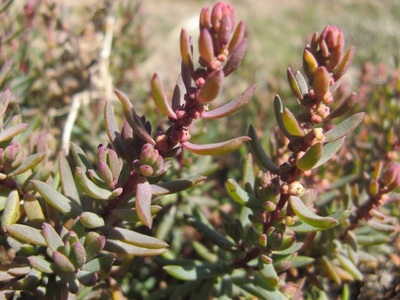Inter-tidal zone
The two main types of inter-tidal plant communities we have in Brisbane Water are saltmarsh and mangroves. Despite the obvious visual differences between them they share important characteristics and play similar roles in maintaining the ecological health of the waterway. They:
- are biologically rich and diverse
- contain plants plants that have evolved with powerful means to enable them to tolerate a high salt environment.
- are important nurseries and habitat for fish, crustaceans and shellfish
- provide important foods for permanent and temporary residents, such as migratory birds, fish, shellfish and crustaceans
- trap sediment that helps reduce turbidity of coastal waters
- protect the shoreline by reducing erosion and providing protection from waves and water movement
- help maintain a balance between each other and adjacent communities such as seagrass beds
Saltmarsh

Saltmarsh is a vegetation community which are found in the high tide zone of estuaries and lagoons. Wheras mangroves are inundated with every high tide, saltmarsh tends to be only inundated by the higher tides with extended periods where the plants are deprived of moisture. Saltmarsh plant species must therefore be extremely hardy as well as salt resistant.
Central Coast saltmarsh plants include:
Although there are many examples of healthy saltmarsh in neighbouring areas such as Empire Bay and Cockle Bay, the saltmarsh communities in Hardy’s Bay and Pretty Beach/Wagstaffe have been degraded over time. The changes to the foreshore from the creation of sea walls and the stabilisation required for the roads, reserves and waterfront living have substantially reduced the amount of suitable habitat. It is possible that the growth of mangroves around the bay have also contributed to the decline of healthy saltmarsh.
What we are left with are just clumps of Juncus (Sea Rush) scattered around the foreshore.
Central Coast saltmarsh plants include:
- rushes and sedges such as Isolepis nodosa (Knobby Club rush), Juncus krausii (Sea Rush),
- tidal flat specialist plants such as Sarcocornia quinqueflora (Glasswort, Samphire) and Suadea australis (Austral Seablite)
- grasses such as, Zoysia macrantha (Coast Couch) and Sporobolus virginicus (Sand Couch)
Although there are many examples of healthy saltmarsh in neighbouring areas such as Empire Bay and Cockle Bay, the saltmarsh communities in Hardy’s Bay and Pretty Beach/Wagstaffe have been degraded over time. The changes to the foreshore from the creation of sea walls and the stabilisation required for the roads, reserves and waterfront living have substantially reduced the amount of suitable habitat. It is possible that the growth of mangroves around the bay have also contributed to the decline of healthy saltmarsh.
What we are left with are just clumps of Juncus (Sea Rush) scattered around the foreshore.
Mangroves

The dominant plant in the mangrove communities found in Brisbane water and the Hawksbury is Avicennia marina or grey mangrove. It is named after the famous Arab physician Avicenna (980-1037). The pencil-like aerial roots that stick up from the surrounding mud are characteristic of this species. Grey mangroves can grow to 9 meters. We have one spectacular large individual opposite Pretty Beach school.
Many indigenous foods were obtained from mangrove environments, including shellfish mud crabs, mangrove worms, and fish The fruit was eaten and the bark was used to treat stingray stings. Mangrove timber has been used to construct canoes, paddles, spears and boomerangs.
The stands of mangrove in our own area are relatively healthy. The main community is around the mouth of Mudflat creek on the Northern shores of Hardy's Bay. This has expanded over recent decades as the silt has built up in this area. Smaller stands of mangroves are found along Araluen Dr. between Mudflat Creek and Killcare Rd, around the mouth of the Creek near the RSL club, and along the dog-track between the end of Araluen DR and the Pretty Beach Boat ramp.


